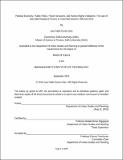| dc.contributor.advisor | Balakrishnan Rajagopal. | en_US |
| dc.contributor.author | Durán Ortiz, Juan Pablo | en_US |
| dc.contributor.other | Massachusetts Institute of Technology. Department of Urban Studies and Planning. | en_US |
| dc.coverage.spatial | s-ck--- | en_US |
| dc.date.accessioned | 2016-02-29T14:00:13Z | |
| dc.date.available | 2016-02-29T14:00:13Z | |
| dc.date.copyright | 2015 | en_US |
| dc.date.issued | 2015 | en_US |
| dc.identifier.uri | http://hdl.handle.net/1721.1/101297 | |
| dc.description | Thesis: S.M., Massachusetts Institute of Technology, Department of Urban Studies and Planning, 2015. | en_US |
| dc.description | This electronic version was submitted by the student author. The certified thesis is available in the Institute Archives and Special Collections. | en_US |
| dc.description | Cataloged from student-submitted PDF version of thesis. | en_US |
| dc.description | Includes bibliographical references (pages 161-177). | en_US |
| dc.description.abstract | Colombia is the second country with most displaced persons in the world, and one of the worst in human rights violations. Despite the popular believe that these human rights violations are due to the internal conflict with guerillas, this thesis found that rather, the largest share of violence, displacement, and human rights violations are due to development and linked with specific economic projects. Colombia has had three peaks of violence and humanitarian crisis. The first two were due to a reorganization in the power structures of the country. However, the last and worst peak of violence in Colombia is due to a specific economic agenda. It began with the imposition of the neoliberal ideology in the nineties. Neoliberalism made the State weaker which allowed a momentary coalition between the ruling class and the drug dealers who grabbed land from poor peasants and from the State in order to obtain financial gains. This thesis also studies how national and international elites were able to take advantage of every stage in the US foreign policy, and in the Bretton Woods Institutions policies in order to create new forms of speculative wealth. This process has created around 10 million of hectares of monopolized land, and more than 7 million of victims. The vast majority of the victims are poor and unarmed peasants. Research findings also suggest that the current peace process will deepen the existing development model, which uses internal violence as a tool for 'development'. The peace agreement with guerrillas only will be possible under principles of impunity for "the ruling coalition", legalization of denuded lands based on "property rights" principles, a greater regression in land reform, and the imposition of "Free Trade" and "Market Discipline" for Colombia in its relations with international partners. | en_US |
| dc.description.statementofresponsibility | by Juan Pablo Durán Ortiz. | en_US |
| dc.format.extent | 177 pages | en_US |
| dc.language.iso | eng | en_US |
| dc.publisher | Massachusetts Institute of Technology | en_US |
| dc.rights | M.I.T. theses are protected by copyright. They may be viewed from this source for any purpose, but reproduction or distribution in any format is prohibited without written permission. See provided URL for inquiries about permission. | en_US |
| dc.rights.uri | http://dspace.mit.edu/handle/1721.1/7582 | en_US |
| dc.subject | Urban Studies and Planning. | en_US |
| dc.title | Political economy, public policy, power structures, and human rights violations : the case of internally displaced persons in Colombia between 1993 and 2010 | en_US |
| dc.type | Thesis | en_US |
| dc.description.degree | S.M. | en_US |
| dc.contributor.department | Massachusetts Institute of Technology. Department of Urban Studies and Planning | |
| dc.identifier.oclc | 939633595 | en_US |
